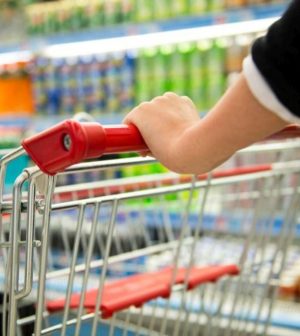- Fragments of Bird Flu Virus Found in U.S. Milk Supply
- There’s an ‘Epidemic’ of Loneliness Among U.S. Parents, Poll Finds
- Infertility Is Rising Among Young Married Women
- New Rules Mean 3.6 Million Americans Could Get Wegovy Via Medicare, Costing Billions
- ‘Dream It, Be It?’ Study Finds Teens Who Focus on Life Goals Often Succeed
- Trying ‘Magic Mushroom’ Drug to Ease Depression? It Has Side Effects
- $282 Billion: What Mental Illness Costs America Each Year
- Black, Hispanic Americans Getting Savvier About CPR
- Kids With Common Skin Conditions Face Stigma, Bullying
- Science Reveals How Aspirin Prevents Colon Cancer
Pandemic Changed Grocery Shopping for Rich and Poor

Changes in Americans’ grocery shopping habits during the pandemic made pre-existing gaps in access to food even worse, researchers report.
While many wealthier people switched to online ordering and did more stocking up, most low-income people still had to shop in-person at local small grocers and dollar stores and do so regularly because they couldn’t afford to stock up on groceries.
That’s the finding of a study that examined 2020 data on in-person traffic at nearly 400 grocery sellers in the Columbus, Ohio, area before lockdown (Jan. 6 – March 15), during lockdown (March 16 – April 19) and during initial reopening (April 20 – May 31).
While mid- and high-end grocery stores and big-box food retailers in the city had significant drops in foot traffic during lockdown, dollar stores and smaller independent grocers — particularly in low-income neighborhoods and those serving many people of color — had only a small decrease in customer visits.
“Most low-income people still had to shop for groceries in person during the COVID lockdowns and may not have had the economic ability to stock up on food,” said lead study author Armita Kar, a doctoral student in geography at Ohio State University.
“They took fewer trips to mid- and high-end grocery stores outside their neighborhood and continued to go regularly to the stores that were nearest to them, which were the dollar stores and local grocers,” Kar said in a university news release.
The problems faced by poor people during pandemic lockdowns aren’t new, according to study co-author Huyen Le, an assistant professor of geography at Ohio State.
“COVID-19 exacerbated the existing problems of unequal access to food for low-income people,” Le said.
“The rich and poor were mostly shopping at different food stores before COVID-19, and those differences became even more stark when the lockdown came,” said study co-author Harvey Miller, director of Ohio State’s Center for Urban and Regional Analysis.
The findings highlight the need to provide better food shopping options for low-income people who live in so-called food deserts, according to Le.
“Dollar stores mostly offer packaged and highly processed foods that aren’t healthy,” Le said. “Policymakers should examine ways to provide better shopping options for people in low-income areas, so they have better access to healthy foods.”
The study will be published in the September issue of the journal Applied Geography.
More information
The U.S. Department of Agriculture offers tips for healthy eating on a budget.
SOURCE: Ohio State University, news release, July 19, 2021
Source: HealthDay
Copyright © 2024 HealthDay. All rights reserved.










